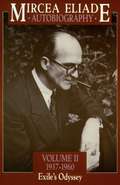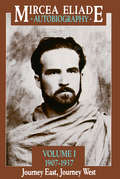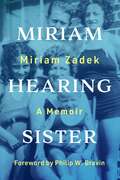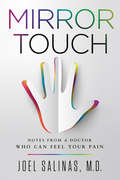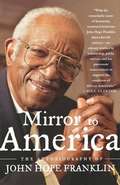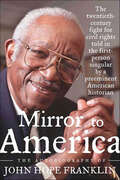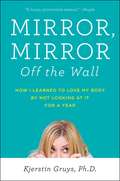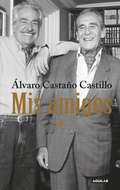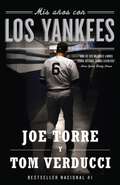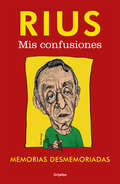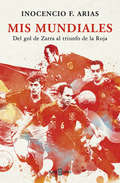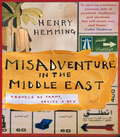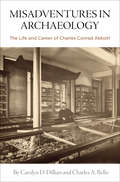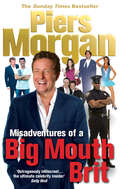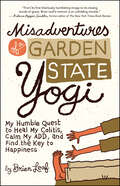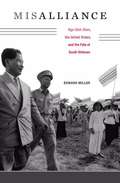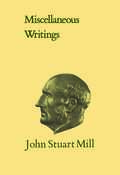- Table View
- List View
Miranda Mania: An Unauthorized Biography
by Lexi RyalsMiranda Cosgrove is impossible to resist--she has two hit shows on Nickelodeon, iCarly and Drake & Josh, and her first single "Leave It All to Me" is a Hot 100 hit.<P><P> She's starred in movies like School of Rock and Yours, Mine & Ours and guest starred on some of the coolest shows on television.
Mircea Eliade: Exile's Odyssey, 1937–1960
by Mircea Eliade"Here finally are Eliade's memoirs of the first thirty years of his life in Mac Linscott Rickett's crisp and lucid English translation. They present a fascinating account of the early development of a Renaissance talent, expressed in everything from daily and periodical journalism, realistic and fantastic fiction, and general nonfiction works to distinguished contributions to the history of religions. Autobiography follows an apparently amazingly candid report of this remarkable man's progression from a mischievous street urchin and literary prodigy, through his various love affairs, a decisive and traumatic Indian sojourn, and active, brilliant participation in pre-World War II Romanian cultural life."—Seymour Cain, Religious Studies Review
Mircea Eliade: Journey East, Journey West, 1907–1937
by Mircea Eliade"Here finally are Eliade's memoirs of the first thirty years of his life in Mac Linscott Rickett's crisp and lucid English translation. They present a fascinating account of the early development of a Renaissance talent, expressed in everything from daily and periodical journalism, realistic and fantastic fiction, and general nonfiction works to distinguished contributions to the history of religions. Autobiography follows an apparently amazingly candid report of this remarkable man's progression from a mischievous street urchin and literary prodigy, through his various love affairs, a decisive and traumatic Indian sojourn, and active, brilliant participation in pre-World War II Romanian cultural life."—Seymour Cain, Religious Studies Review
Miriam Hearing Sister: A Memoir
by Miriam ZadekMiriam Zadek shares her story in this memoir that documents her experiences growing up in a New York Jewish family with both deaf and hearing members from the 1930s through World War II and beyond. Her story is personal and reflective, revealing the sometimes complex and heart-rending dynamics within her family and her community. Through brief and evocative vignettes, Zadek relates her memories of family life, capturing the innocence of childhood, the confusion of adolescence, and then progressing through adulthood. Her recollections evolve from a childlike observance to awareness, pain, and understanding as she matures. Throughout this journey, the author presents a narrative of historical and cultural importance centered on her personal account of the lives of deaf and hearing Jewish people in the mid-twentieth century. The prevailing ideological movements of the time permeate her family life. Zadek reveals the traumatic impact of eugenics and the fears surrounding the genetic transmission of deafness. She considers the effects of adhering to the oral method of communication in her home when sign language could have given her family the ability to interact with each other more fully. In this environment, Zadek became an astute communicator and learned to adapt to both the hearing and the deaf world, where she was known as “Miriam Hearing Sister.” Her memoir is an elegant literary work that offers an understanding of how biases and stigmas resonate and evolve, and it showcases her loving family of strong women who pushed against stereotypes and have thrived across generations.
Miriam's Kitchen
by Elizabeth EhrlichLike many American Jews, Elizabeth Ehrlich was ambivalent about her background. She identified with Jewish cultural attitudes, but not with Jewish institutions; she had sentimental memories of her ritually observant grandmothers, but formal religious practice was largely irrelevant to her life. In this warm, funny, moving, and immensely appetizing memoir, she describes how her attitudes evolved, and how she began to bring observance and tradition into her own home. The agent of change was Ehrlich's mother-in-law, Miriam. A Holocaust survivor, Miriam passionately carried out the traditions she had learned as a girl. Inspired to preserve a lost way of life'and also to ?build a floor? of values, connection, and history beneath her children's feet?Ehrlich begins cooking lessons with the indomitable Miriam. As Miriam cooks, she speaks of the past and wakes dormant memories and appetites in her skeptical daughter-in-law. With trepidation and a certain amount of backsliding, Ehrlich begins observing Sabbath and moves toward making her kitchen kosher. In the process, she gains a new appreciation of life's possibilities, choices, and limitations.
Miriam: A Novel
by Lois T. HendersonMiriam retells the profoundly moving story of Moses' older sister, whose instrumental role in the Exodus is only part of her destiny. Miriam's greatest struggle is within her own heart; her ultimate victory is a hard-won faith--strengthened in the crucible of the desert, tested by her own pride and arrogance, and ultimately affirmed by God's mercy and grace. Retaining biblical authenticity while resourcefully filling in historical, cultural, and narrative details, Lois Henderson skillfully mingles historical events--the devastation of the plagues, the miracle of the manna, the receiving of the Ten Commandments--with brilliantly realized portraits of some of the Old Testament's most famous figures, bringing alive the excitement and epic drama of Moses' return to Egypt and the deliverance of the children of Israel. Watching history unfold through Miriam's eyes, sharing in the joy, pain, doubt, and ultimate faith at the heart of her story, the reader is caught up in the destinies of Miriam, Moses, their brother Aaron, the Israelite people, and the world. Watch for Lydia and more books about women of the bible by Lois T. Henderson.
Mirror Touch: Notes from a Doctor Who Can Feel Your Pain
by Joel SalinasChallenging our understanding of what it means to be human, Joel Salinas, a Harvard-trained researcher and neurologist at Massachusetts General, shares his experiences with mirror-touch synesthesia, a rare and only recently identified neurological trait that causes him to feel the emotional and physical experiences of other people. Performing a spinal tap, he feels the needle slowly enter his lower back. If a disoriented patient flies into a confused rage, Salinas slips into a similarly agitated physical state, and when a patient dies, he experiences an involuntary ruin—his body starts to feel vacant and lifeless, like a limp balloon. Susceptible to the pain and discomfort of his patients, most of whom suffer from a host of disorders and extreme injuries, Salinas uses his trait to treat their symptoms, almost as if they were his own. At the same time, in his personal life, his mirror touch blurs the boundaries between himself and those close to him until he ends up inextricably entangled, no longer able to differentiate where he ends and someone else begins. Salinas refers to his condition as a kind of compulsory mindfulness, a heightened empathic ability that offers him invaluable clues about how to see and live the world through other people’s perspectives. This heightened sense of awareness is at the center of Mirror Touch. Through his experiences, both in his neurological practice and his personal life, Salinas offers readers insights about mirror-touch synesthesia and how the brain, in its endless wonder, can sometimes perform in a nearly superhuman, extrasensory way. In the process, Salinas reveals the full power and potential of his trait, as well as its thorny complications and often debilitating limitations. Beautifully written with intelligence and compassion and anchored by the latest developments in neurology, psychology, and psychiatry, Mirror Touch is an enthralling and wholly original investigation into the unexplored corners of the brain, where the foundation of human experience and relationships take root—everything it means to think, to feel, and to be.
Mirror to America: The Autobiography of John Hope Franklin
by John Hope FranklinJohn Hope Franklin lived through America's most defining 20th Century transformation -- the dismantling of legally-protected racial segregation. He was and remains, an active participant. Born in 1915, he, like every other African American, could not but participate: he was evicted from whites-only train cars, confined to segregated schools, threatened-once with lynching-and consistently met with racism's denigration of his humanity. He has reshaped the way African American history is understood and taught and become one of the world's most celebrated historians, garnering over 130 honorary degrees. But Franklin's participation was much more fundamental than that. From his effort in 1934 to hand President Franklin Roosevelt a petition calling for action in response to the Cordie Cheek lynching, to his 1997 appointment by President Clinton to head the President's Initiative on Race, and continuing to the present, Franklin has influenced with determination and dignity the nation's racial conscience. Whether aiding Thurgood Marshall's preparation for arguing Brown v. Board in 1954, marching to Montgomery, Alabama, in 1965, or testifying against Robert Bork's nomination to the Supreme Court in 1987, Franklin has pushed the national conversation on race towards humanity and equality, a life-long effort that earned him the Presidential Medal of Freedom, the nation's highest civilian honor, in 1995.
Mirror to America: The Autobiography of John Hope Franklin
by John Hope FranklinJohn Hope Franklin lived through America's most defining twentieth-century transformation, the dismantling of legally protected racial segregation. A renowned scholar, he has explored that transformation in its myriad aspects, notably in his 3.5-million-copy bestseller, From Slavery to Freedom. Born in 1915, he, like every other African American, could not help but participate: he was evicted from whites-only train cars, confined to segregated schools, threatened—once with lynching—and consistently subjected to racism's denigration of his humanity. Yet he managed to receive a Ph.D. from Harvard; become the first black historian to assume a full professorship at a white institution, Brooklyn College; and be appointed chair of the University of Chicago's history department and, later, John B. Duke Professor at Duke University. He has reshaped the way African American history is understood and taught and become one of the world's most celebrated historians, garnering over 130 honorary degrees. But Franklin's participation was much more fundamental than that.From his effort in 1934 to hand President Franklin Roosevelt a petition calling for action in response to the Cordie Cheek lynching, to his 1997 appointment by President Clinton to head the President's Initiative on Race, and continuing to the present, Franklin has influenced with determination and dignity the nation's racial conscience. Whether aiding Thurgood Marshall's preparation for arguing Brown v. Board of Education in 1954, marching to Montgomery, Alabama, in 1965, or testifying against Robert Bork's nomination to the Supreme Court in 1987, Franklin has pushed the national conversation on race toward humanity and equality, a life long effort that earned him the Presidential Medal of Freedom, the nation's highest civilian honor, in 1995. Intimate, at times revelatory, Mirror to America chronicles Franklin's life and this nation's racial transformation in the twentieth century, and is a powerful reminder of the extent to which the problem of America remains the problem of color.
Mirror, Mirror Off the Wall
by Kjerstin GruysA scholar, fashionista, and bride-to-be spends a year without mirrors to get a better view of herself, her life, and what's really important. When Kjerstin Gruys became engaged to the love of her life, she was thrilled--until it came time to shop for a wedding dress. Having overcome an eating disorder years before, Gruys found herself struggling to maintain a positive self-image as her pending nuptials imposed a new set of impossible beauty standards. She decided to embark on a bold plan for boosting her self-esteem while refocusing her attention on the beautiful world around her. A memoir of discovery, Mirror Mirror Off the Wall charts Gruys' awakening as she vows to give up mirrors and other reflective surfaces, relying instead on her friends and her fiancé to help her gauge both her appearance and her outlook on life. The result? A renewed focus on what truly matters, regardless of smeared makeup, crooked eyebrows, or messy hair. In the honest, witty, self-aware voice that has made her blog so popular, Gruys explores what it means to be a feminist in a society where femininity is subject to destructive ideals of beauty and sex appeal. Having worked in the fashion industry before becoming a sociologist, Gruys draws on her frontline expertise to explore the gender inequities created by society's obsession with a flawless female body image. Putting a human face on an important issue with humorous and poignant scenes from Gruys' life, Mirror Mirror off the Wall sparks important conversations about body image and reclaiming the power to redefine beauty.
Mirrored Minds: Soren Kierkegaard and Hans Christian Andersen
by Kate AshtonIn her unique dual biography, Kate Ashton delineates the parallel lives of Hans Christian Anderson and Sen Kierkegaard, their personal relationship, literary careers, and lasting cultural influence on the western and wider world. These two towering literary geniuses followed radically divergent paths, and yet each read and reacted to the immense power and depth of the other's growing oeuvre as it refracted their own. Against the backdrop of the end of Golden Age Denmark within a warring Europe, and the spiritual and sexual repression of Reformed Christianity, each suffered the fate of the prophet unhonoured in his hometown of Copenhagen. Tracing their lives from childhood trauma to tragic love affairs and anguished isolation, Ashton illuminates counteractive response to experience: one an inward search for truth and self-knowledge, the other flight into distraction and fantasy. Mirrored Minds offers the reader an opportunity to explore each author and his legacy within the context of the other, just as their long-standing association held up a mirror for Anderson and Kierkegaard themselves.
Mirrors of Greatness: Churchill and the Leaders Who Shaped Him
by David ReynoldsA new biography of Winston Churchill, revealing how his relationships with the other great figures of his age shaped his own triumphs and failures as a leader Winston Churchill remains one of the most revered figures of the twentieth century, his name a byword for courageous leadership. But the Churchill we know today is a mixture of history and myth, authored by the man himself. In Mirrors of Greatness, prizewinning historian David Reynolds reevaluates Churchill&’s life by viewing it through the eyes of his allies and adversaries, even his own family, revealing Churchill&’s lifelong struggle to overcome his political failures and his evolving grasp of what &“greatness&” truly entailed. Through his dealings with Adolf Hitler and Neville Chamberlain, we follow Churchill&’s triumphant campaign against Nazi Germany. But we also see a Churchill whose misjudgments of allies and rivals like Roosevelt, Stalin, Gandhi, and Clement Attlee blinded him to the British Empire&’s waning dominance on the world stage and to the rising popularity of a postimperial, socialist vision of Great Britain at home. Magisterial and incisive, Mirrors of Greatness affords Churchill his due as a figure of world-historical importance and deepens our understanding of his legend by uncovering the ways his greatest contemporaries helped make him the man he was, for good and for ill.
Mis amigos
by Álvaro Castaño CastilloAlvaro Castaño es uno de las personalidades intelectuales más queridasen el país, y aquí nos habla de sus grandes amigos del mundo cultural A los 94 años, Álvaro Castaño Castillo tiene todavía muchas cosas quecontar. En este, el último libro de su vida, seamanguala con la memoria lúcida que a su edadno lo traiciona ni por un instante, para escribirlas anécdotas de las que fue testigo, y que fueronel resultado de eternas amistades con los pensadores, escritores,periodistas y políticos más in?uyentes del Siglo XX de Colombia y deAmérica. Estos son sus amigos. Alvaro Castaño es uno de las personalidades intelectuales más queridasen el país, y aquí nos habla de sus grandes amigos del mundo cultural A los 94 años, Álvaro Castaño Castillo tiene todavía muchas cosas quecontar. En este, el último libro de su vida, seamanguala con la memoria lúcida que a su edadno lo traiciona ni por un instante, para escribirlas anécdotas de las que fue testigo, y que fueronel resultado de eternas amistades con los pensadores, escritores,periodistas y políticos más in?uyentes del Siglo XX de Colombia y deAmérica. Estos son sus amigos.
Mis años con los Yankees
by Joe Torre Tom VerducciLa historia definitiva de una de las grandes dinastías en la historia del béisbol, los New York Yankees de Joe Torre Cuando Joe Torre tomó posesión como manager de los Yankees en 1996, no habían ganado una Serie Mundial en dieciocho años. Durante ese tiempo, diecisiete managers habían intentado hacerse con las riendas del equipo de béisbol más famoso de América. Todos fueron despedidos por George Steinbrenner, el dueño del equipo. Después de doce exitosas temporadas --con doce apariciones consecutivas en los playoffs, seis títulos de la Liga Americana y cuatro Series Mundiales-- Torre dejó los Yankees como el más querido manager del béisbol. Su mayor cualidad fue saber tratar a jugadores como Alex Rodríguez, Mariano Rivera, Jason Giambi, Derek Jeter, Roger Clemens o Randy Johnson. Aquí, por primera vez, Joe Torre y Tom Verducci llevan a los lectores dentro de los propios Yankees, mostrando lo que de verdad hizo falta para mantener al equipo en lo más alto del béisbol mundial.From the Trade Paperback edition.
Mis confusiones: Memorias desmemoriadas (Biblioteca Rius #Volumen)
by RiusLa biografía definitiva de Rius, escrita por él mismo.Un texto imprescindible para los lectores del creador de Los Agachados, Mis Supermachos y más de un centenar de libros publicados la mayoría en esta casa editorial a partir de éste 2014 la biblioteca disponible en digital.Rius cumple 80 años de edad -60 como caricaturista- y publicará su último y muy esperado libro Mis confusiones, se titula así, como una parodia a Mis confesiones de San Agustín.
Mis mundiales: Del gol de Zarra al triunfo de la Roja
by Inocencio F. AriasEl apasionante recorrido de la Copa del Mundo, desde 1950 hasta la actualidad, contado con rigor y sentido del humor por Inocencio F. Arias. Un viaje personal cuajado de información deportiva y anécdotas mezcladas con el contexto histórico y diplomático en el que se celebró cada mundial. Desde el mítico gol de Zarra en el estadio de Maracaná hasta el Iniestazo que proclamó a la Roja campeona del mundo por primera vez, pasando por la maldición de cuartos, el fiasco del 82, la mano de Dios o el cabezazo de Zidane, todo aficionado al fútbol disfrutará con la narración de un testigo de excepción y forofo incondicional del deporte rey. Inocencio F. Arias viaja por cada uno de los mundiales que vivió para hablar también de su propia historia, de cómo el fútbol marcó el devenir de España desde la dictadura hasta la democracia, y de cómo ese fenómeno deportivo ha afectado a la economía y a la sociedad internacionales. Un libro que demuestra que la historia del fútbol es también la historia de nuestro tiempo.
Mis pedazos rotos: Sanando las heridas del abuso sexual a través de la fé, la familia y el amor
by Rosie RiveraPor ser la más pequeña de los Rivera, Rosie estuvo rodeada de amor incondicional, apoyo y afecto, y no había nada que su familia no habría hecho por ella, en particular su hermana Jenni, quien, para Rosie, era lo más importante en el mundo. Con una fuerte voluntad y principios sólidos, Rosie estaba lista para conquistar el mundo. Sin embargo, su vida daría un vuelco drástico cuando Rosie fue marcada por el abuso sexual del que fue objeto dentro de su familia a una muy temprana edad. Viviendo con miedo y oprimida por secretos dolorosos, estuvo agobiada por amenazas constantes, confusión y dolor. No sólo le fue arrebatada su infancia, sino también su confianza y su autoestima. Sintiéndose completamente hecha pedazos y perdida, Rosie se hundió en un mundo de hábitos destructivos y en una profunda depresión.Por primera vez y con inquebrantable franqueza y valentía, Rosie comparte los traumáticos detalles de los abusos que sufrió, de su lucha diaria para salir adelante y de cómo gracias al cariño de su familia encontró, una vez más, el amor. Pero aún así, poco después la vida de Rosie sería duramente impactada otra vez cuando fue sacudida por la peor tragedia que podría haber imaginado y su más mayor miedo se hizo realidad: la muerte de su amada hermana.En la misma medida desgarradora y edificante, la historia de Rosie constituye un testimonio verídico sobre la superación de la adversidad y una muestra de que a pesar de vivir los peores momentos posibles y sin importar cuántos retos se presenten en la vida, es siempre posible sobreponerse a las desgracias y encontrar la fuerza y la voluntad necesarias para soñar y vivir nuevamente. CON FOTOGRAFÍASPrólogo de Mryka Dellanos.From the Trade Paperback edition.
Mis rincones oscuros
by James EllroyLas desgarradoras memorias de la investigación de Ellroy sobre el asesinato de su madre. Mis rincones oscuros es el libro más intimista y el reflejo más oscuro del pasado del autor y de una experiencia que marcaría toda su obra. En junio de 1958, James Ellroy tenía diez años cuando recibió la terrible noticia del asesinato de su madre. El cadáver de Geneva Hilliker fue hallado cubierto de hiedra en una cuneta de las afueras de Los Ángeles, estrangulado con una cuerda y unas medias de nylon y con signos evidentes de violación. El caso no se resolvió, pero la brutal muerte marcó para siempre la vida del autor y fue el germen de toda su obra. En 1994, después de publicar el último volumen del «Cuarteto de los Ángeles», Ellroy decidió descubrir la verdad sobre el crimen. Para ello contrató los servicios de un veterano y experimentado «detective» llamado Bill Stoner. A medida que ambos avanzaban en este caso enterrado desde hacía treinta años, Ellroy descubría el misterio que en realidad fue su madre, cuáles fueron sus aspiraciones y por qué decidió salir de un pequeño pueblo de Wisconsin para empezar una nueva vida en Los Ángeles. Mis rincones oscuros relata esta investigación, en una mezcla de crónica negra y memorias confesionales, y se convierte en un libro fascinante que proporciona las claves autobiográficas de sus novelas y, a su vez, en la introducción perfecta a la perturbadora obra de este autor imprescindible de la novela del siglo XX. Críticas:«Un círculo obsesivo que se tensa hasta formar un nudo... amargo, retorcido, introspectivo.»New York Magazine «Una lectura para estómagos y mentes fuertes. No hay ninguna concesión al sentimentalismo. [...] [Ellroy] ha vuelto a elevar la novela negra [...] a la categoría que adquirió conDashiellHammett, Raymond Chandler y los que inauguraron el género hacia 1930.»Mariano Antolín Rato, El Mundo «Extraña y perversamente fascinante. Mitad thriller, mitad grito de dolor. [...] Una crónica sincera sobre el hecho de crecer sintiéndose un extraño, bajo la condena del dolinexpresado.»Newsday «Mis rincones oscuros rompe con las fronteras entre géneros, dando como resultado un clásico singular.»Newsweek
Misadventure in the Middle East
by Henry HemmingExperience the beautifully written tale of a hapless young artist, a beat-up pick-up called Yasmine, and an extraordinary journey across the world. Misadventure in the Middle East: Travels as Tramp, Artist and Spy by Henry Hemming creates a portrait of the post-9/11 Middle East that transports the reader into the human heart of the region. When Henry Hemming sets out in his pick-up truck to make a portrait of the Middle East, he has no idea what he will find or how he will live. Using art as his passport, he spends a year traveling throughout the area; his extraordinary journey finds him accused of being both an Islamic extremist and a British spy, dancing in a dervish hideaway and attending a Fourth of July party with GIs in Saddam Hussein's Republican Palace. As the young people he meets along the way share their dreams and doubts, Hemming discovers an unpredictable Middle East that is in no way accurately represented by the nightly news. And as the invasion of Iraq intensifies, he realizes that in order to finish his portrait, he must go to Baghdad to find a fabled artistic renaissance-a trip that could cost him his life.
Misadventures in Archaeology: The Life and Career of Charles Conrad Abbott
by Carolyn D. Dillian Charles A. BelloA comprehensive portrait of the controversial self-taught archaeologist C. C. Abbott.In the late nineteenth century, Charles Conrad Abbott, a medical doctor and self-taught archaeologist, gained notoriety for his theories on early humans. He believed in an American Paleolithic, represented by an early Ice Age occupation of the New World that paralleled that of Europe, a popular scientific topic at the time. He attempted to prove that the Trenton gravels—glacial outwash deposits near the Delaware River—contained evidence of an early, primitive population that pre-dated Native Americans. His theories were ultimately overturned in acrimonious public debate with government scientists, most notably William Henry Holmes of the Smithsonian Institution. His experience—and the rise and fall of his scientific reputation—paralleled a major shift in the field toward an increasing professionalization of archaeology (and science as a whole).This is the first biography of Charles Conrad Abbott to address his archaeological research beyond the Paleolithic debate, including his early attempts at historical archaeology on Burlington Island in the Delaware River, and prehistoric Middle Woodland collections made throughout his lifetime at Three Beeches in New Jersey, now the Abbott Farm National Historic Landmark. It also delves into his modestly successful career as a nature writer. As an archaeologist, he held a position with the Peabody Museum at Harvard University and was the first curator of the American Section at the Penn Museum. He also attempted to create a museum of American archaeology at Princeton University. Through various sources including archival letters and diaries, this book provides the most complete picture of the quirky and curmudgeonly, C. C. Abbott.
Misadventures of a Big Mouth Brit
by Piers MorganPiers has got a new job. He's off to America to be the 'Nasty Brit' judging the show America's Got Talent - surely a role he was made for? And with unprecedented access to people, places and parties on both sides of the pond, he'll get the inside scoop on the world of celebrity Stateside. So what could possibly go wrong?Well, it's not all plain sailing. Piers finds himself snubbed by the paparazzi and subjected to national ridicule by Alan Sugar. As well as foolishly embarking on a visit to the Playboy Mansion with his girlfriend he also becomes one of the only people to fall off the 'idiot-proof' Segway (George Bush fell off one too).Somehow though, Piers still manages to get invited to all the best parties. Perhaps because he keeps being mistaken for David Cameron? From chinwags with Naomi Campbell to a cigar-smoking session with Arnold Schwarzenegger; hilarious tête-à-têtes with everyone from Boris Johnson to Cheryl Cole; and many bizarre encounters with the likes of Paris Hilton, Tony Blair and Jay-Z, Piers is his usual candid, honest, loudmouth self as he lifts the lid on Tinsel Town.With the background cries of 'Please don't embarrass us Dad!' from his sons, the Big Mouth Brit embarks on his hilarious American adventure, and suffers just a few mishaps along the way.
Misadventures of a Garden State Yogi: My Humble Quest to Heal My Colitis, Calm My ADD, and Find the Key to Happiness
by Brian LeafAs a college freshman business major suffering from a variety of anxiety-related maladies, Brian Leaf stumbled into an elective: yoga. It was 1989. All his classmates were female. And men did not yet generally “cry, hug, or do yoga.” But yoga soothed and calmed Leaf as nothing else had. As his hilarious and wise tale shows, Leaf embarked on a quest for health and happiness — visiting yoga studios around the country and consulting Ayurvedic physicians, swamis, and even (accidentally) a prostitute. Twenty-one years later, he teaches yoga and meditation and is the beloved founder of a holistic tutoring center that helps students whose ailments he once shared.
Misalliance
by Edward MillerIn the annals of Vietnam War history, no figure has been more controversial than Ngo Dinh Diem. During the 1950s, U. S. leaders hailed Diem as “the miracle man of Southeast Asia” and funneled huge amounts of aid to his South Vietnamese government. But in 1963 Diem was ousted and assassinated in a coup endorsed by President John F. Kennedy. Diem’s alliance with Washington has long been seen as a Cold War relationship gone bad, undone either by American arrogance or by Diem’s stubbornness. In Misalliance, Edward Miller provides a convincing new explanation for Diem’s downfall and the larger tragedy of South Vietnam. For Diem and U. S. leaders, Miller argues, the alliance was more than just a joint effort to contain communism. It was also a means for each side to pursue its plans for nation building in South Vietnam. Miller’s definitive portrait of Diem-based on extensive research in Vietnamese, French, and American archives-demonstrates that the South Vietnamese leader was neither Washington’s pawn nor a tradition-bound mandarin. Rather, he was a shrewd and ruthless operator with his own vision for Vietnam’s modernization. In 1963, allied clashes over development and reform, combined with rising internal resistance to Diem’s nation building programs, fractured the alliance and changed the course of the Vietnam War. In depicting the rise and fall of the U. S. –Diem partnership, Misalliance shows how America’s fate in Vietnam was written not only on the battlefield but also in Washington’s dealings with its Vietnamese allies.
Miscellaneous Writings
by John Stuart Mill John RobsonThe interests and activities of John Stuart Mill (1806-73) were so wide-ranging that even the varied subjects of thirty previously published volumes of Collected Works cannot encompass them all. In this volume are brought together diverse and interesting instances of his polymathic career, none before republished and some previously unpublished.Neatly framing Mill's writing career are his editorial prefaces and extensive notes to Jeremy Bentham;s Rationale of Judicial Evidence (1827) and James Mill's Analysis of the Phenomena of the Human Mind (1869). Both demonstrate his extraordinary powers of mind and diligence as well as his fealty. His constant avocation, field botany, is shown in his botanical writings, which open a window on an almost unknown activity that sustained and delighted him. Brief comments on two medical works hint at another interest. Two articles of which he was co-author demonstrate his work as editor of the London and Westminster Review, and a calendar of his contributions to the Political Economy Club provides yet another glimpse into his chosen activities and concerns. Published for the first time are Mill's English and French wills, providing still further biographical detail.

